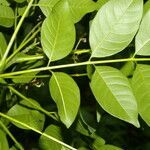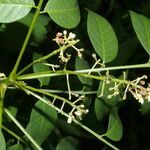Tree to 10 m. tall. Leaves to 35 cm. long; leaflets 6-9 pairs (occasionally leaves bear a terminal leaflet) borne oppositely on the rachis; blades 3-10 cm. long, 1.5-4 cm. wide, lanceolate-elliptical to ovate, inequilateral and acute at the base, the apex usually narrowly acuminate, glabrous to pubescent along the veins above and below to scattered-pilose all over, the underside often lighter than the top. In-florescences axillary, racemose, numerous toward the ends of the twigs, 6-14 cm. long, glabrous to puberulent. Flowers white to lavender, fragrant, 2-3 mm. long, 4-to 6-merous; calyx small, flat, deeply lobed, the lobes deltoid, glabrous to puber-ulent without; petals lanceolate-ovate to ovate, glabrous; staminal ring united only on the basal 1/3, the filaments glabrous without, pilose within near the apex, bear-ing a pair of apicula at the base of the anther; stamens usually twice as many as the petals; ovary densely pilose, the stigma sphaeroidal-capitate. Fruit about 1 cm. long, reddish, densely short-velutinous, occasionally transversely striate as the valves open, 3-to 4-valved, usually 2-to 4-seeded, the seeds red-arillate and persistent.
More
A medium sized tree. The bark is brown or red. The leaves are long and have many pointed leaflets. These are almost opposite along the stalk. There is a leaflet at the end. This leaflet is at a slight angle. There are short hairs on the twigs and under the leaflets. The fruit are woody capsules. They open with 3 valves. The seeds have bright red coverings.
Moist or dry thickets, sometimes in rather open, mixed forest, most commonly found in lowland areas but extending to 1,800 metres. Open forests in the limestone and coastal (chiefly dry coast) regions of Puerto Rico.
More
It is a tropical plant. It grows in the dry zone.



